Moss Side, Manchester Worksheets
Do you want to save dozens of hours in time? Get your evenings and weekends back? Be able to teach about Moss Side, Manchester to your students?
Our worksheet bundle includes a fact file and printable worksheets and student activities. Perfect for both the classroom and homeschooling!
Resource Examples
Click any of the example images below to view a larger version.
Fact File
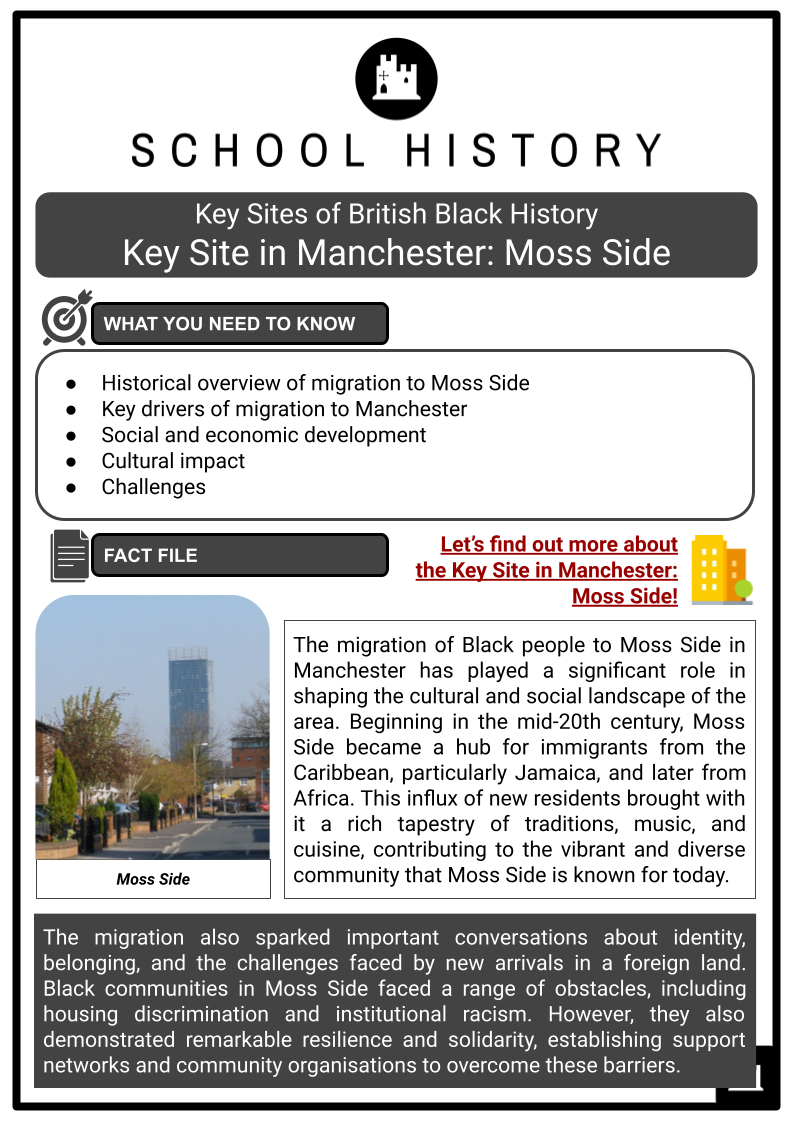
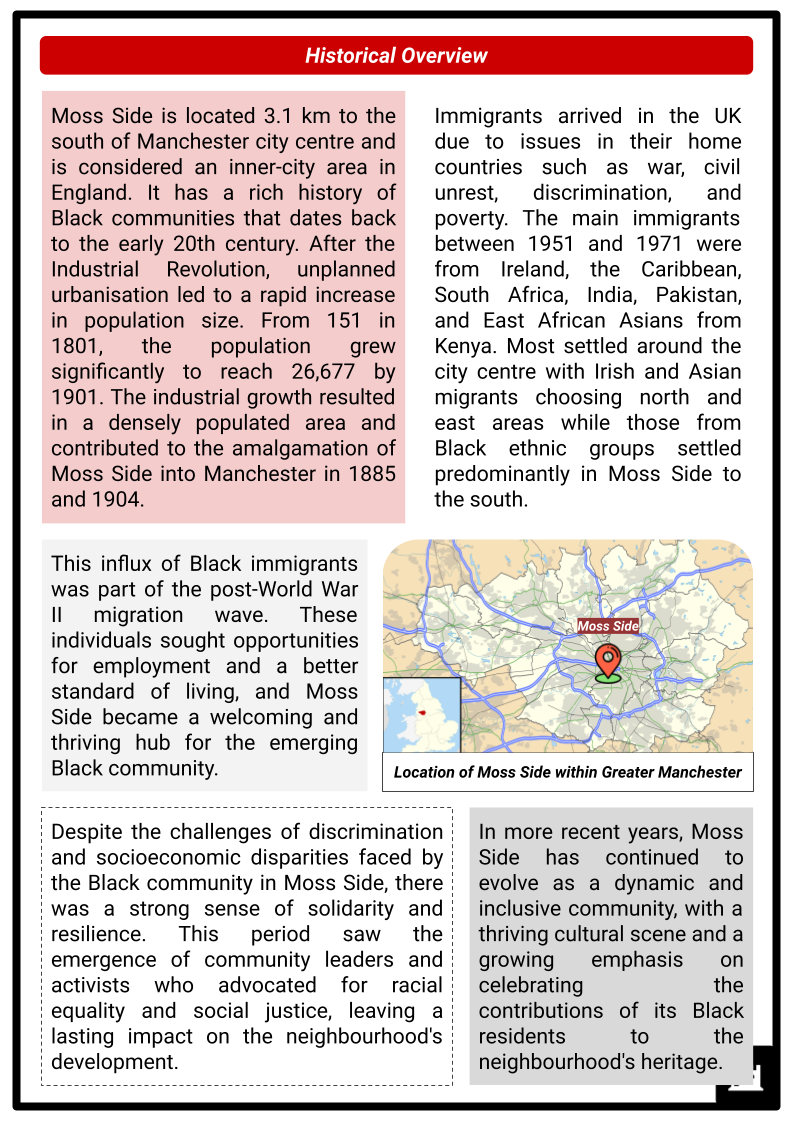
Student Activities
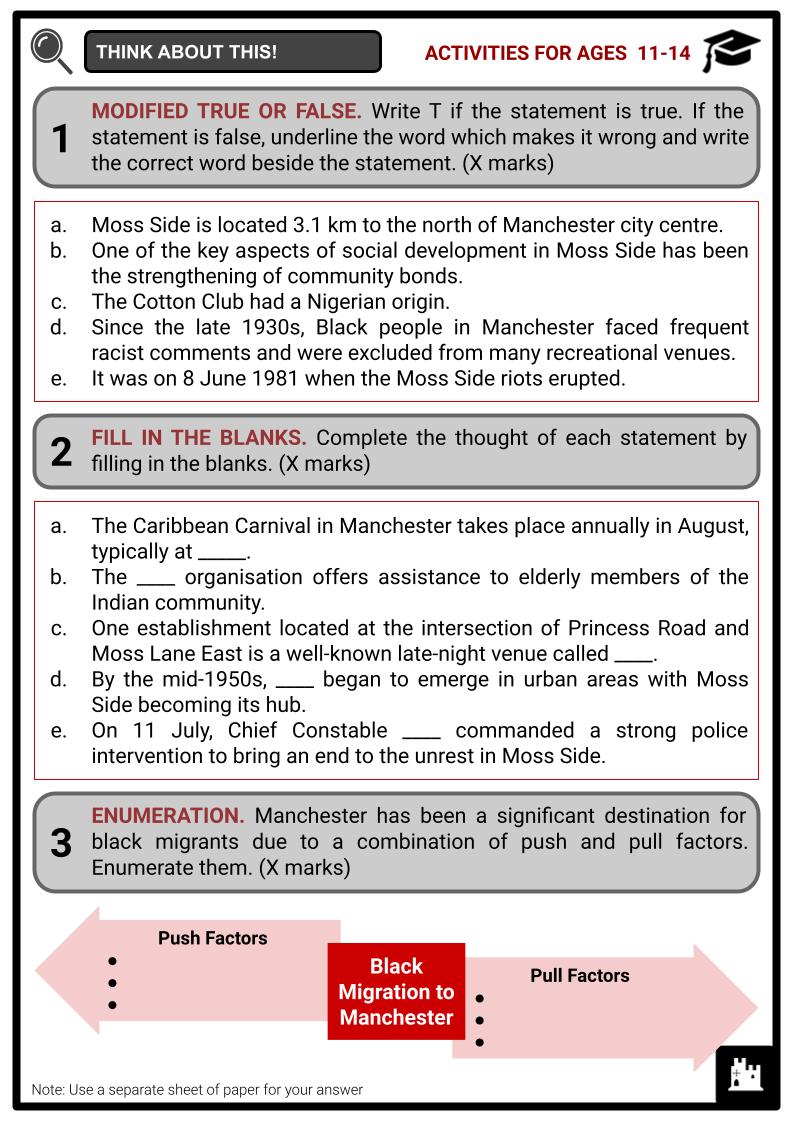
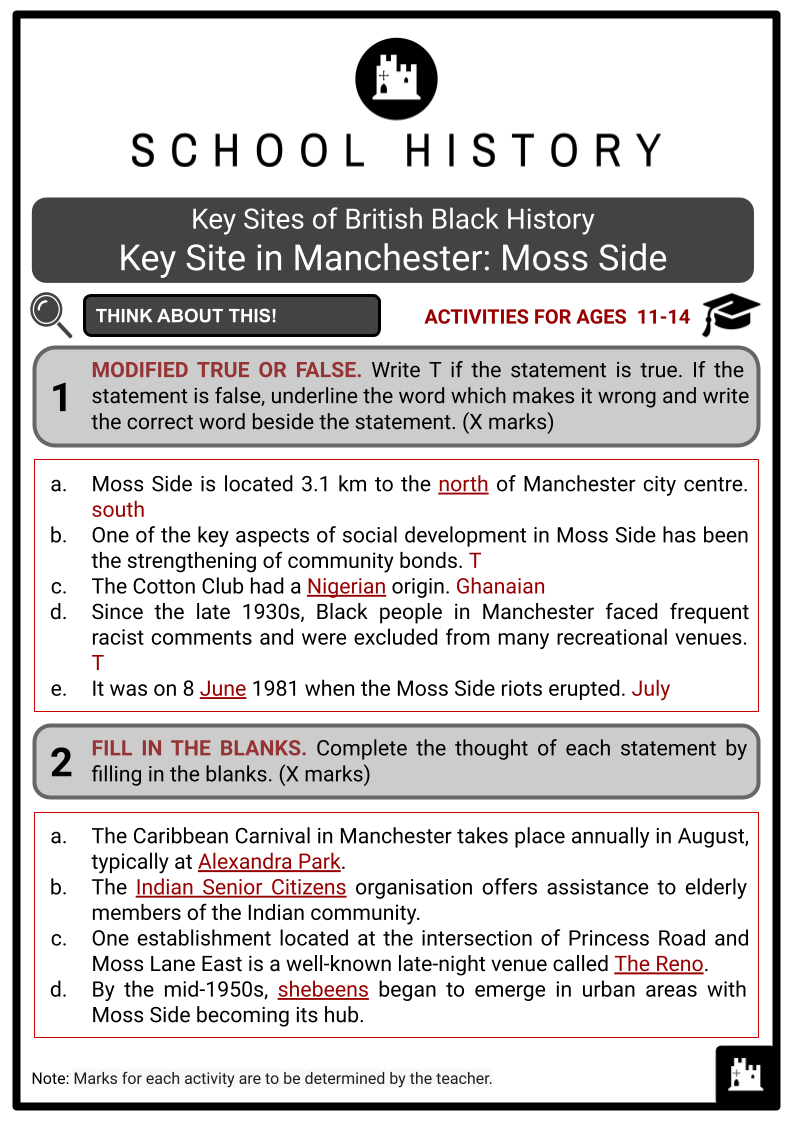
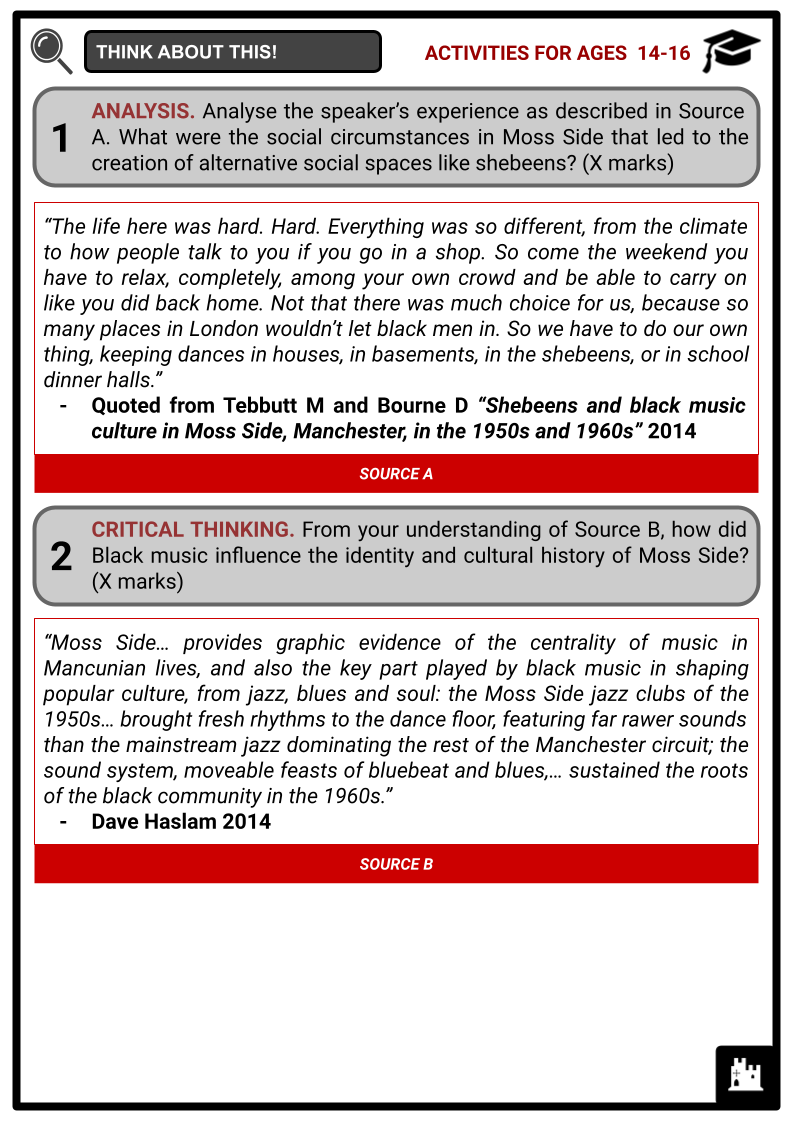
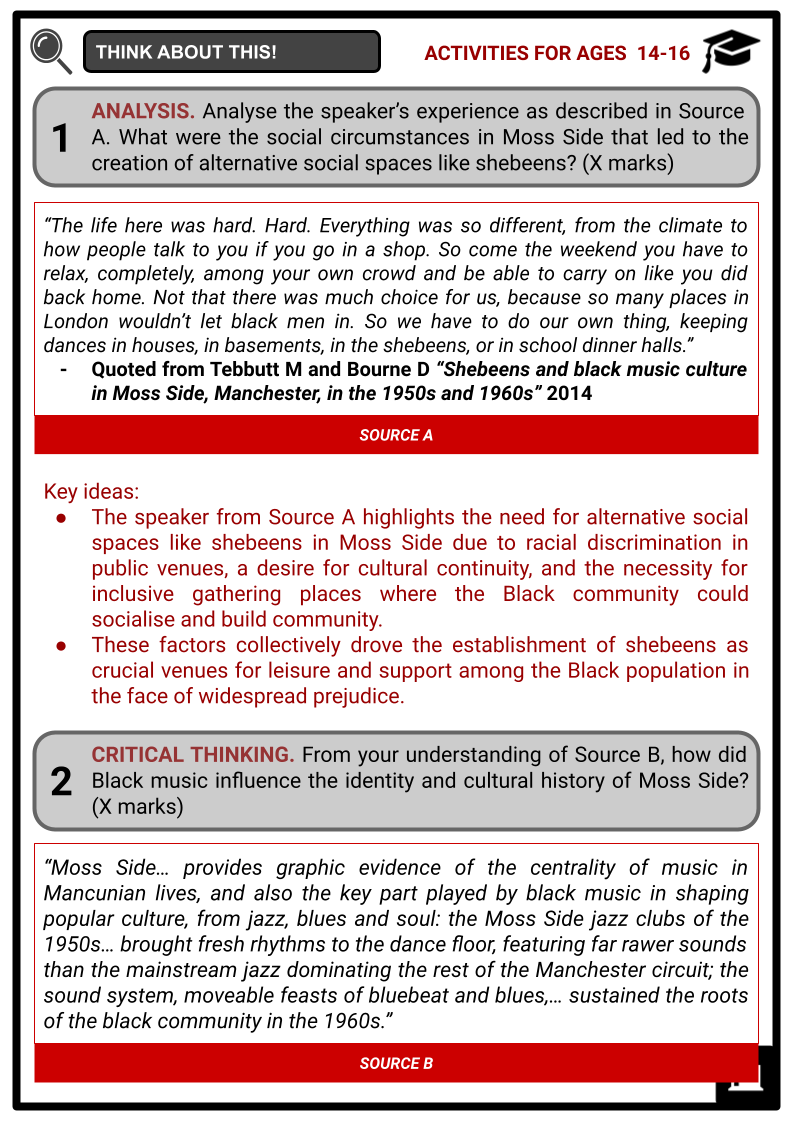
Summary
- Historical overview of migration to Moss Side
- Key drivers of migration to Manchester
- Social and economic development
- Cultural impact
- Challenges
Key Facts And Information
Let’s find out more about the Key Site in Manchester: Moss Side!
The migration of Black people to Moss Side in Manchester has played a significant role in shaping the cultural and social landscape of the area. Beginning in the mid-20th century, Moss Side became a hub for immigrants from the Caribbean, particularly Jamaica, and later from Africa. This influx of new residents brought with it a rich tapestry of traditions, music, and cuisine, contributing to the vibrant and diverse community that Moss Side is known for today.
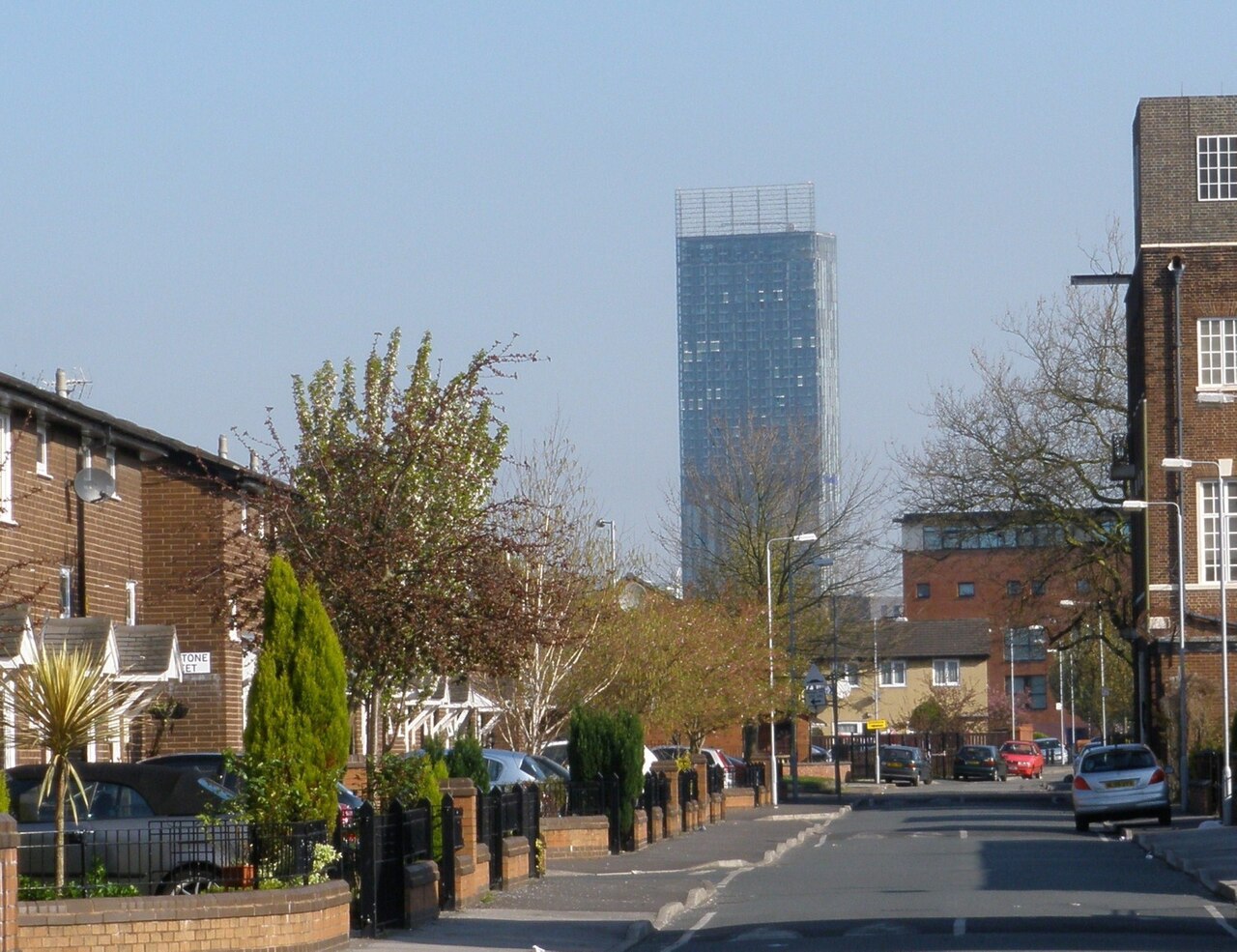
- The migration also sparked important conversations about identity, belonging, and the challenges faced by new arrivals in a foreign land. Black communities in Moss Side faced a range of obstacles, including housing discrimination and institutional racism. However, they also demonstrated remarkable resilience and solidarity, establishing support networks and community organisations to overcome these barriers.
Historical Overview
- Moss Side is located 3.1 km to the south of Manchester city centre and is considered an inner-city area in England. It has a rich history of Black communities that dates back to the early 20th century. After the Industrial Revolution, unplanned urbanisation led to a rapid increase in population size. From 151 in 1801, the population grew significantly to reach 26,677 by 1901. The industrial growth resulted in a densely populated area and contributed to the amalgamation of Moss Side into Manchester in 1885 and 1904.
- Immigrants arrived in the UK due to issues in their home countries, such as war, civil unrest, discrimination, and poverty. The main immigrants between 1951 and 1971 were from Ireland, the Caribbean, South Africa, India, Pakistan, and East African Asians from Kenya. Most settled around the city centre, with Irish and Asian migrants choosing north and east areas, while those from Black ethnic groups settled predominantly in Moss Side to the south.
- This influx of Black immigrants was part of the post-World War II migration wave. These individuals sought opportunities for employment and a better standard of living, and Moss Side became a welcoming and thriving hub for the emerging Black community.
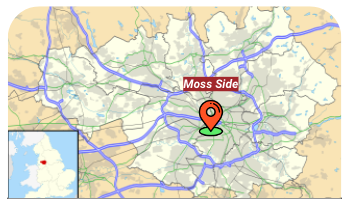
- Despite the challenges of discrimination and socioeconomic disparities faced by the Black community in Moss Side, there was a strong sense of solidarity and resilience. This period saw the emergence of community leaders and activists who advocated for racial equality and social justice, leaving a lasting impact on the neighbourhood's development.
- In more recent years, Moss Side has continued to evolve as a dynamic and inclusive community, with a thriving cultural scene and a growing emphasis on celebrating the contributions of its Black residents to the neighbourhood's heritage.
Key Drivers of Migration
- Manchester has been a significant destination for black migrants due to a combination of push and pull factors. The push factors include political and economic instability in their home countries, such as the impact of colonialism and decolonisation, civil unrest, and economic hardships. These factors have driven many Blacks to seek opportunities and a better quality of life abroad.
Black Migration to Manchester
- Push Factors
- Political and economic instability in their home countries
- Impact of colonialism and decolonisation, civil unrest, and economic hardships
- Seek opportunities and a better quality of life abroad
- Pull Factors
- Promise of employment
- Development of industries
- Need for labour in the post-WWII era
- Presence of existing Black communities
- Establishment of cultural and religious institutions
- On the other hand, the pull factors of Manchester, and the UK more broadly, have been the promise of employment, the development of industries, and the need for labour in the post-World War II era. The demand for workers in sectors such as transportation, healthcare, and manufacturing provided an opportunity for Black migrants to find employment and contribute to the rebuilding of the country after the war.
- Furthermore, the presence of existing Black communities in areas like Moss Side created a supportive environment for incoming migrants, with social networks providing practical assistance, guidance, and a sense of belonging. The establishment of cultural and religious institutions also played a crucial role in attracting and retaining black migrants in Manchester, providing a familiar and supportive environment as they adjusted to life in a new country.
- Overall, the key drivers of Black migration to Manchester have been a complex interplay of historical, economic, and social factors, shaping the vibrant and diverse communities that continue to contribute to the rich tapestry of the city's heritage.
Social and Economic Development
- Moss Side has undergone significant social and economic development over the years, influenced by the contributions and resilience of its Black communities. The neighbourhood has experienced both progress and challenges, shaping its present-day landscape and future prospects.
- One of the key aspects of social development in Moss Side has been the strengthening of community bonds and the preservation of cultural heritage. The Black community has played a pivotal role in establishing vibrant cultural institutions, organising events, and celebrating traditions that have enriched the social fabric of the neighbourhood. The presence of churches, community centres, and grassroots organisations has provided essential support networks and spaces for communal gatherings, fostering a strong sense of belonging and unity among residents.
- Several local community and volunteer organisations offer social assistance, along with cultural and recreational activities for the residents. These groups encompass The West Indian Sports and Social Club, the African and Caribbean Mental Health Service, as well as the African-Caribbean Care Group, catering to the Afro-Caribbean population.
- The Caribbean Carnival in Manchester takes place annually in August, typically at Alexandra Park. This Carnival is a celebration of Caribbean culture, featuring vibrant music, colourful costumes, and delicious food.
- It attracts thousands of visitors from all over the city and beyond, contributing to the local economy and showcasing the diversity and talents of Moss Side's Black communities.
- The Indian Senior Citizens organisation, on the other hand, offers assistance to elderly members of the Indian community. Moreover, the Somali Bravanese Sisters and Polish School Manchester serve the needs of the Somali and Polish communities, respectively.
- Moss Side has also witnessed significant economic development driven in part by the entrepreneurial spirit of its Black residents. Small businesses, shops, and eateries established by members of the Black community have not only contributed to the local economy but have also added to the neighbourhood's unique character.
- One establishment is located at the intersection of Princess Road and Moss Lane East. It is a well-known late-night venue called The Reno and it was founded by a Nigerian. The Reno and its upstairs counterpart, the Nile, were prominent drinking establishments for Manchester's West Indian community and significantly influenced the evolution of Black culture within the city.
- Other establishments are the Cotton Club, which had a Ghanaian origin, and the Kroo Club, which had links to Sierra Leone and Liberia. The entrepreneurial endeavours of Black business owners have created employment opportunities, supported local commerce, and added to the overall vibrancy of Moss Side's commercial landscape.
- However, it is important to acknowledge the persistent economic disparities and challenges faced by some residents in Moss Side, including issues of unemployment, access to affordable housing, and disparities in educational and economic opportunities. These challenges underscore the ongoing need for targeted social and economic initiatives to address inequities and create pathways for inclusive development in Moss Side.
- In recent years, initiatives focused on urban regeneration and community-led projects have aimed to enhance the quality of life for all residents of Moss Side. These efforts have encompassed urban renewal programs, investment in community infrastructure, and the promotion of cultural tourism, all of which contribute to the social and economic revitalisation of the neighbourhood.
Cultural Impact
- The cultural impact of Black communities in Manchester is a multifaceted and integral part of the city's heritage. One of the most prominent is evident in the realm of music and the arts. Black individuals and communities have been instrumental in shaping Manchester's music scene, particularly in genres such as reggae, ska, and soul.
- Their influence can be traced to the emergence of vibrant music venues, record shops, and community spaces that became hubs for showcasing and celebrating Black musical traditions. Notably, Moss Side has been a thriving centre for musical innovation and expression, with local artists and performers contributing to the city's reputation as a cultural melting pot.
- African and West Indian social clubs started to emerge in Moss Side during the late 1930s, offering a communal space for Black residents to meet, interact, and showcase their cultural heritage. Some of these clubs were associated with specific ethnic communities, highlighting the economic success of certain Africans who had acquired enough wealth to invest in local real estate.
- Shebeens were also established as informal, underground gathering places where Black communities could socialise, enjoy music, and preserve their cultural traditions in the face of discrimination and exclusion from mainstream venues. The music heard in the shebeens and clubs provided them with a chance to enjoy their favourite tunes that they felt were not being played on the BBC or commercial radio stations.
- Moreover, the culinary landscape of Manchester has been enriched by the presence of Black communities, with the introduction of vibrant and flavourful cuisines that reflect the diversity of their cultural heritage.
- Restaurants, eateries, and food markets offering Caribbean, West African, and other Black diasporic cuisines have not only provided culinary delights but have also become spaces for community gathering and the sharing of cultural traditions.
- In addition to music and cuisine, the cultural impact of Black communities in Manchester is evident in the realm of literature, fashion, and visual arts. Black writers, designers, and artists have contributed to the city's creative tapestry, infusing it with narratives, styles, and perspectives that celebrate their heritage and experiences.
- Furthermore, the cultural impact of Black communities extends to the fostering of inclusive spaces and events that promote cultural exchange, dialogue, and understanding. Festivals, heritage celebrations, and community gatherings organised by Black communities have not only provided opportunities for collective expression but have also facilitated intercultural interactions that have enriched the social fabric of Manchester. These initiatives have played a vital role in promoting mutual respect, unity, and appreciation for the diversity of cultural expressions within the city.
Challenges: The Moss Side Riots
- The migration of Black individuals and families to Moss Side was initially driven by the demand for labour during the post-war period, as industries in the UK sought workers to contribute to the country's reconstruction and economic growth.
- One of the initial challenges faced by Black migrants in Moss Side was the prevalence of racial discrimination and prejudice. The influx of Black individuals into predominantly white neighbourhoods led to tensions and conflicts, resulting in instances of discrimination in housing, employment, and social interactions.
- These challenges underscore the systemic barriers that Black migrants had to navigate as they sought to establish themselves in Moss Side, facing barriers to integration and access to opportunities. Since the late 1930s, when numerous social clubs and community organisations run by African-Caribbeans began to emerge, Black people in Manchester faced frequent racist comments and were excluded from many recreational venues.
- This reinforced the significant social role played by both licensed clubs and unlicensed shebeens as crucial gathering places within a well-established infrastructure by the late 1940s.
- By the mid-1950s, shebeens began to emerge in urban areas with Moss Side becoming its hub. They grew in number throughout Manchester from the mid-1950s to the early 1960s. The shebeens were already viewed as hubs for illegal activities and immorality by the early 1950s. Police had mixed attitudes towards these illicit establishments.
- Initially, the establishment and growth of clubs and shebeens serving the Black community were motivated by the racial bias faced by African and Caribbean migrants in Manchester. This discrimination permeated various aspects of their daily lives, including leisure and entertainment. Black individuals encountered exclusion from or denial of service at pubs and clubs across the city.
- In response, they took the initiative to establish and manage their own establishments where they could enjoy music that was not readily accessible in mainstream venues or on popular radio stations.
- In 1981, Moss Side was one of the inner city areas in England that experienced a series of riots. The events were a manifestation of the simmering discontent and frustration stemming from systemic discrimination, economic disparities, and tensions between the police and the local community. Moreover, mass unemployment brought about by the early 1980s recession exacerbated existing social and economic challenges for Black communities in Moss Side.
- It was on 8 July 1981 when the Moss Side riots erupted. More than 1000 young people took to the streets, protesting against perceived racial injustice and police brutality. Police backup with riot shields and protective helmets were sent to surround the station.
- The eruption of civil unrest led to widespread damage to local businesses, infrastructure, and properties.
- The protests continued for 48 hours over two nights despite the efforts of both the community leaders and the Greater Manchester Police. The incidents involved extensive burning and looting of shops along Princess Road, Claremont Road, Rusholme, and other surrounding areas. On 11 July, Chief Constable James Anderton commanded a strong police intervention to disperse the protesters and bring an end to the unrest in Moss Side.
- A team of 560 officers from a mobile task force, using 50 transit vans and Land Rovers, had been organised at local police stations in the vicinity of the protests. During a span of two hours, 150 individuals were taken into custody without any injuries reported among the police personnel. Subsequently, the Moss Side section of Princess Road was shut down for several days to facilitate repairs to adjacent structures and gas mains damaged during the rioting and fires.
- Despite these challenges, the Black community in Moss Side demonstrated incredible resilience and solidarity, establishing support networks and community organisations to address the systemic issues they faced.
- A public gathering of more than 300 individuals on 5 August 1981, concluded to establish a defence committee, known as the Moss Side Defence Committee, in order to oppose the criminalisation of Black youth in Manchester. This committee provided support for those who were detained during the disturbances and initiated a grassroots inquiry to examine the circumstances.
- The Black community in Moss Side continues to navigate challenges related to socioeconomic disparities, educational opportunities, and representation in decision-making processes. However, the resilience and determination of the community have led to the emergence of initiatives aimed at addressing these challenges, including educational programs, economic empowerment endeavours, and advocacy for inclusive policies that uplift the Black residents of Moss Side.
Image Sources
- https://upload.wikimedia.org/wikipedia/commons/thumb/3/3d/Brentwood_Street_in_Moss_Side_-_Manchester.jpg/1280px-Brentwood_Street_in_Moss_Side_-_Manchester.jpg
- https://upload.wikimedia.org/wikipedia/commons/thumb/4/44/Greater_Manchester_UK_location_map_2.svg/1280px-Greater_Manchester_UK_location_map_2.svg.png
Frequently Asked Questions
- What is the historical significance of Moss Side in Manchester in terms of Black history?
Moss Side, located in Manchester, has a rich history related to black communities, dating back to the mid-20th century when many Caribbean immigrants settled in the area. It became a focal point for cultural expression, activism, and community development.
- When did the first Black communities settle in Moss Side?
During the 1950s and 1960s, Moss Side witnessed an influx of Caribbean immigrants who came to the UK in response to labour shortages.
- How did Moss Side contribute to the development of Black British culture?
Moss Side played a crucial role in shaping Black British culture by fostering a vibrant community that celebrated its Caribbean roots. The area became known for its cultural events, music, and cuisine, contributing to the broader tapestry of multiculturalism in the UK.
